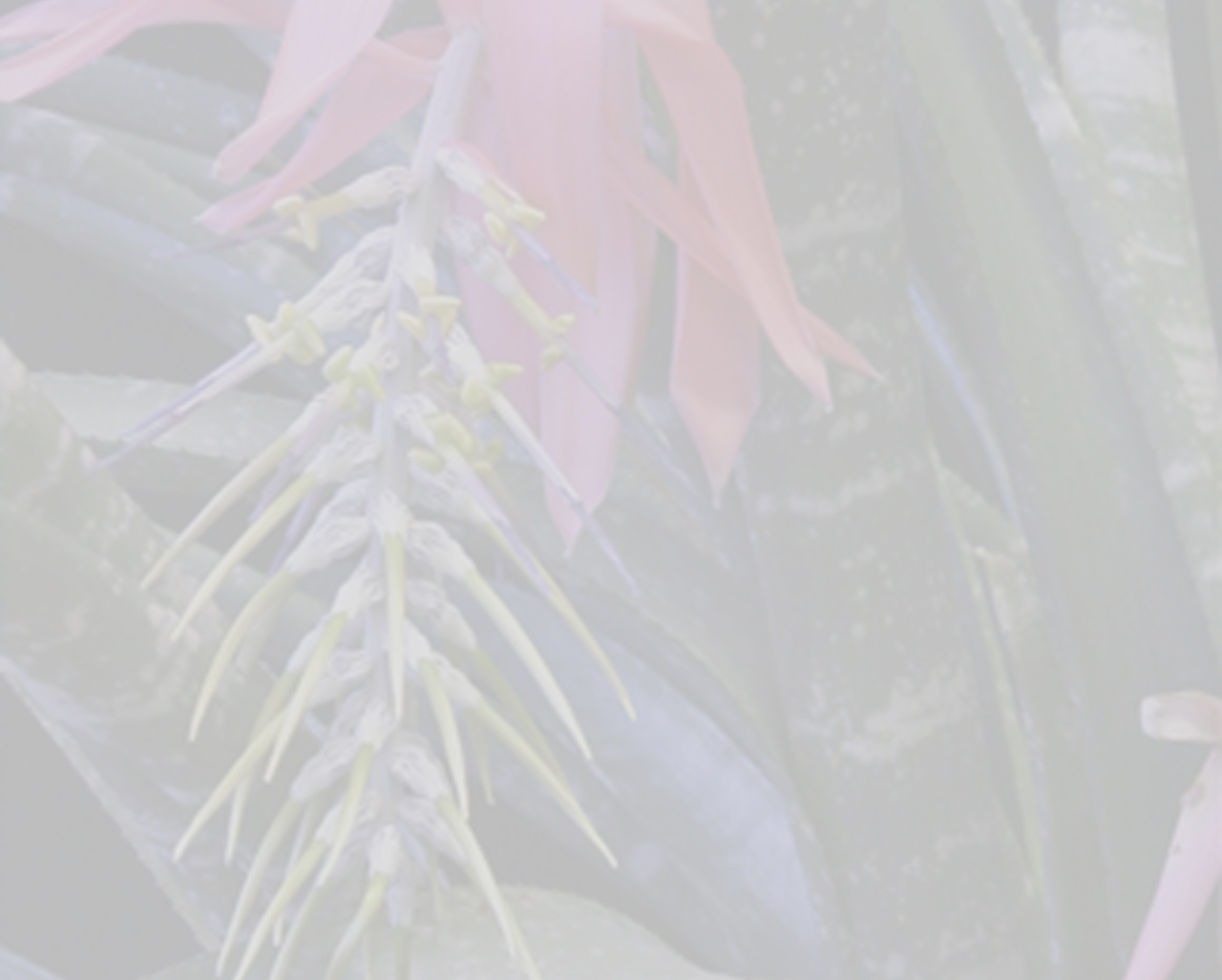


plant epiphytic, acaulis. leaves forming an infundibuliform rosette, 35–55 cm long, chartaceous, parallel nerved, prominent on the back; sheath 8–15 x 4–8 cm, oblong to oblong elliptic, clear green when fresh, pale yellow-coffee when dry, densely dotted lepidote on both surfaces, except toward the edges, the scales rounded, coffee in the center and white-yellow toward the edges, edges toward the base membranaceous and entire, toward the top chartaceous and toothed, spines 1.5–2 mm long; blade 20–47 x 4–6 cm in its widest part, oblong (ligulate), slightly contracted and canaliculate toward the base, green concoloured on both surfaces, except for the canaliculate centre part that is paler, dotted lepidote on both surfaces, but denser toward the base, the scales rounded, coffee in the center and cream toward the outside, toothed margins, spines antrorse, distributed laxly along the whole blade, the basal ones 1–3 mm long, the apical ones ca 1 mm long or less, tip obtuse and apiculate, frequently reflexed. inflorescence: peduncle 40 - 46 cm long, 1.4–2.5 mm diameter toward the base, 2.4–4.2 mm diameter toward the apex, seemingly arched, orange to rosy, dotted lepidote, grooved, more or less visible; peduncle bracts spiraled, 33 - 57 x 9–12 mm, increasing gradually in size toward the apex, the bottom ones adpressed to the peduncle, not imbricate but shorter than the internodes, the upper ones diffused, but longer than the internodes and imbricate, oblong-elliptic to ovate, membranaceous, orange-red, densely pubescent or lepidote toward the apex, parallel and prominent nerved on both surfaces, base amplexicaule, apex acuminate to attenuate and glabrescent, edges entire along all their length or entire only toward the base and laxly toothed toward the apex, spines less than 0.5 mm long; fertile part terminal , once-branched, with 2 - 4 primary branching toward the base, the branches aborted toward the apex and then the flowers are directly attached to the main axis of the inflorescence, deflexed, lax, 13–22 x 8–14 cm, pyramidal mature; rachis of the inflorescence visible, 12–20 cm long, 2.5–4 mm diameter toward the base and ca 1 mm toward the apex, orange to rosy, dotted lepidote and with deciduous tomentum, especially at the point of union with the peduncles of the spikes; primary bracts deflexed, 4–5.5 x 1–1.6 cm, but longer than the internodes, shorter than the spikes, elliptic ovate, membranaceous, orange, glabrous or sparsely only tomentose toward the extreme tip, indumento deciduous with time, parallel and prominent nerved on both surfaces, apex acuminate, margins entire, sometimes laxly serrate, with spines less than l mm long; peduncle of the spike visible, 6–20 mm long, ca 1 mm diameter, orange to rosy, sparsely dotted lepidote; spikes spiraled, 4.5–7.5 cm long, with (1 -) 2–3 (–4) flowers, rachis visible; floral bracts generally perpendicular to the rachis, much shorter than the pedicels, not imbricate, polystichous, 1–2 x 1–2 mm, deltoid to ovate, glabrous, nerves inconspicuous, apex acuminate, ecarinate, margins entire. flowers polystichously arranged not evident, lax, perpendicular to erect in respect to the rachis, imbricate; pedicel up to 43 mm long, 0.5–1 mm diameter, orange to rosy, laxly lepidote, grooved; perianth seemingly actinomorphic and without an epigynous tube; calyx 11–13 mm long, connate for 2 mm; lobes free 9–11 mm long, oblong, lightly asymmetric, chartaceous and membranaceous toward the edges (especially in wider side), rosy, glabrescent on the adaxial surface and sparsely lepidote on the abaxial surface, ecarinate, with 7 parallel veins that travel lengthwise and prominent on the adaxial surface, rounded apex, slightly cucullate and emarginate, margins entire; petals free, seemingly not wound individually into a hairspring towards anthesis and afterwards has contorted remains, 32–40 x 5 mm, spatulate, membranaceous, sparsely lepidote on both surfaces, with near 17 parallel veins that travel lengthwise and sometimes forked toward the apex, the adaxial surface with a couple of pleats that they travel lengthwise from the base to 23–31 mm of its total length, apex rounded and cucullate, margins entire; ligules 2 at the base of each petal, 3–4 x 1–2 mm, epipetalous 2–3 mm long, with the lateral edges fused to form a sack and with a long appendix and directed upwards that originate toward the middle part but are circular near to the edges of the petal, the apical edges free and crenate. stamens 37–38 mm long, episepalous, the first verticil free and with filaments 35 x 1 mm, the second verticil epipetalous and with the part free from the filaments 6 x 1 mm; filament flattened and sparsely lepidote; anther 5 x 1 mm, oblong-elliptic, dorsifixed. pistil: ovary inferior, 7 mm long, 5.5 mm diameter, obconic, continuous with the calyx, slightly grooved, green, lepidote, with placentation axilla and subapical, ovules caudate; style 36 mm long, stigma 2 mm long, divided into three lobes and densely papillose toward the internal upper edge.
Edited from (7---0-2019): Betancur & Salinas 2006. El ocaso de Pseudaechmea (Bromeliaceae: Bromelioideae) .